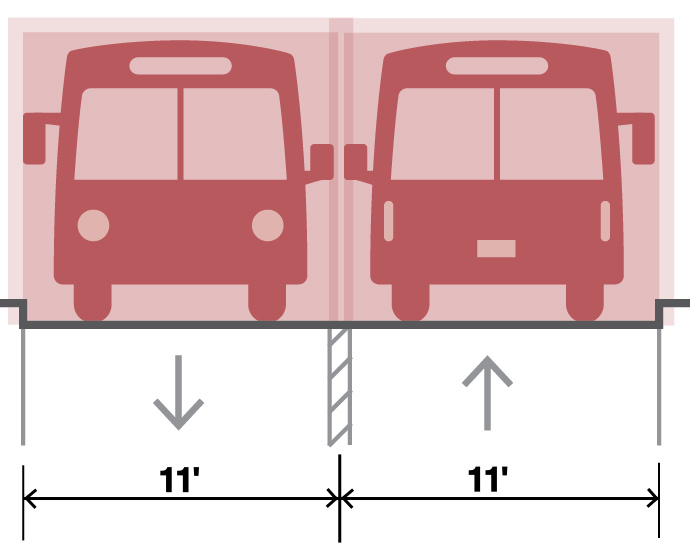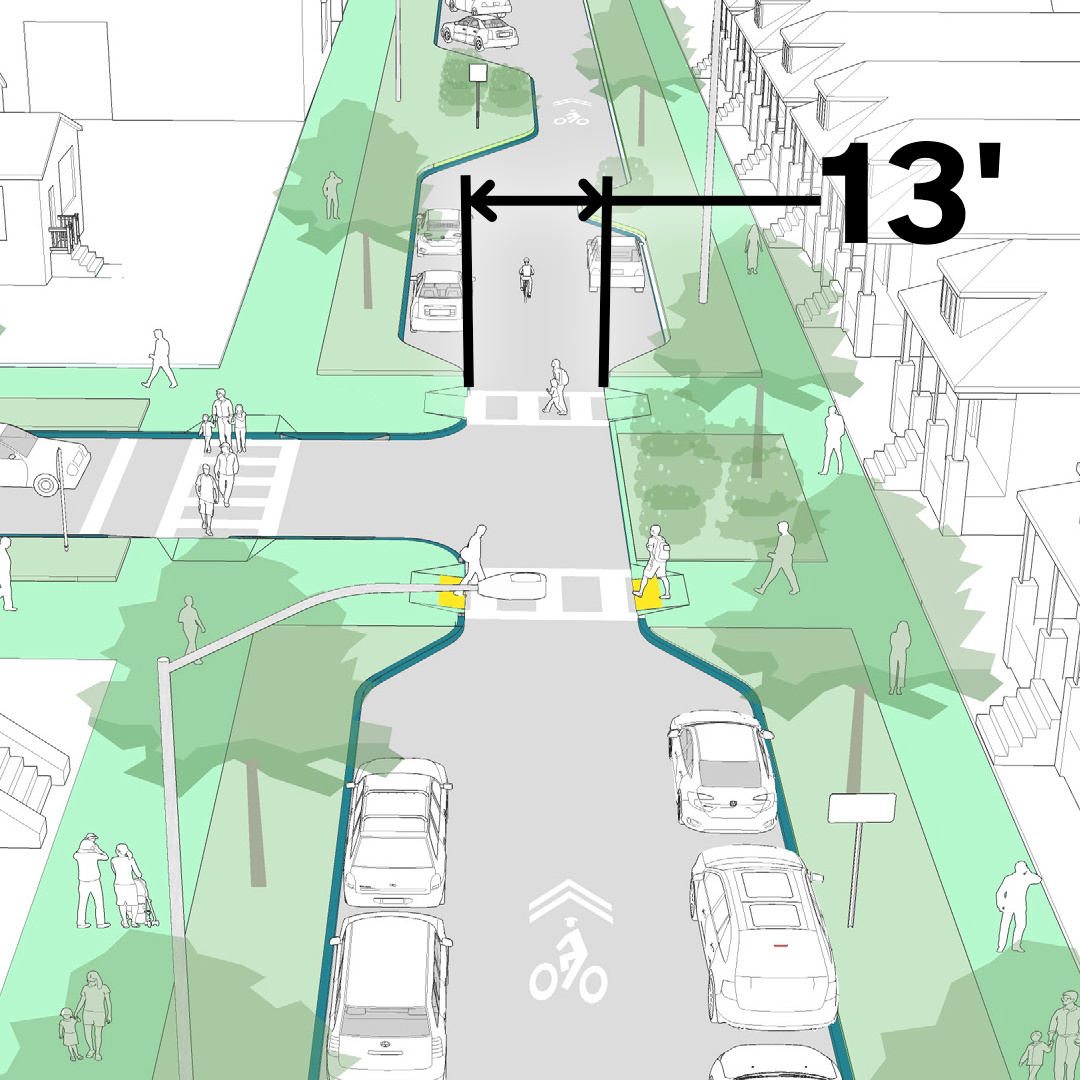This post is part of a Street Design Standards series.
Narrower lanes are generally correlated with slower speeds, reduced collisions, and safer streets.
Our recommendations:
- Lane widths instituted as maximums (rather than minimums)
- Maximum 10 feet for any streets 30+ mph (except limited cases)
- Increased flexibility for streets designed for 25 mph or lower
Over 80% of the fatalities and serious injuries (KSI) on Sacramento roadways happen on streets signed between 30 mph and 45 mph. Taking a serious approach to Vision Zero will mean addressing these higher-speed, higher-volume roads. Both a reclassification of these roads (discussed later) and redesign of the current geometry to appropriate speeds is crucial.

There are many (re)design options along the scale of cost and efficacy. One of the cheapest treatments with measurable safety and speed-reduction benefits is changing the effective road widths by reducing the width (or number) of lanes.
Managing lane widths is an important and fundamental tool in the toolbox of street (re)design. Narrowing lane widths on city streets is a fundamental building block to healing our streets and provides a host of benefits including:
- Ability to reallocate unused street space
- Visual cues to drivers on appropriate speed
- Reduces collision rates between cars as well as other users
- Reduce crosswalk lengths
- Increase pedestrian safety
- Decrease time cars spend waiting at signals
From Minimums to Maximums

Similar to parking mandates, the use of the ‘minimum standard’ has led to an over-allocation of public space in Sacramento to vehicles. In historical context, this requirement made sense as US city standards have largely been adopted from highway design, where wider lanes do typically correlate to reduced crashes between vehicles.
Our systematic over-allocation of lane width citywide can also be viewed as an opportunity as most streets now have between 2 to 14+ feet of extra space (with a road diet or parking removal) for other community or transportation uses.
Safety
Narrower lane widths on arterials and collectors (30+ mph) can be an effective measure to reduce both speed and number of collisions.
Significant research has been done to identify the safety benefits of 10-foot lane widths in urban settings (see: additional reading). Recent research from Johns Hopkins indicates that reduction of lane widths down to 9 feet in many cases may provide additional safety benefits, including fewer collisions. When controlling for other geometric factors, researchers found 12-foot traffic lanes experienced approximately 1.5 times more non-intersection collisions than 9-foot lanes.

A note of caution here as lane width reductions alone may appear to have underwhelming speed reduction results (cars travel roughly 1 to 3 mph slower per foot reduced). However, in the context of vehicular speed, just a few miles per hour can be the difference between a broken bone and death. Studies indicate that when lane width reductions are combined with other forms of traffic calming (e.g. posting new speed limits, landscaping, etc.) additional permenant speed reductions can often be achieved. When implemented as one part of a comprehensive program, lane width reductions are an integral component to increasing safety.
Design Exceptions

While 10-foot maximum lane widths should generally be considered the standard, they are not appropriate in all locations. High-frequency transit and truck routes may require at least one lane to be 11 feet and may be considered the standard maximum width in these cases. Larger receiving lanes in urban areas with tight corner radii may also be required for bigger vehicles to safely complete turns. Other implementations of lanes wider than 10 feet should be permissible but require written justification by a licensed engineer.
Local Streets

We recommend increased flexibility in the standards for local streets that are designed for slower travel. These streets enable the largest variation in uses and lane width should not be a defining characteristic (if it exists at all) so much as overall width of the right-of-way. Details of local streets will be discussed in an upcoming post.
Supporting Standards
Adopting 10-foot travel lane widths on arterials and urban collector streets is an established concept that appears to already under consideration by the City of Sacramento. With recent research showing increased safety benefits of 9-feet lanes we encourage the city to explore beyond the 10-foot standard and have provided a few cities or standards where 9- or 10-foot widths are already adopted for various situations.
- Detroit Design Guidelines (10’ travel lanes)
- Los Angeles Complete Streets Design Guidelines (9’ travel lanes)
- VermontDOT (9’ travel lanes)
- Amsterdam, Berlin, Copenhagen, Paris, Tokyo, Toronto (9.2′ – 10.6′ travel lanes)
- NACTO Design Guidelines (9’-10’ travel lanes)
- AASHTO Green Book (10’ travel lanes)
Additional Reading
- A National Investigation on The Impacts of Lane Width on Traffic Safety. (Johns Hopkins School of Public Health)
- Urban Design Guidelines (National Association of City Transportation Officials)
- Why 12-Foot Traffic Lanes are Disastrous and Must Be Replaced Now (Jeff Speck, Bloomberg)
- The Influence of Lane Widths on Safety and Capacity (Theodore Petritsch, P.E. PTOE)
- Narrow Lanes, Safer Streets (Dewan Masud Karim, P.Eng PTOE, Research Gate)
- Standard Car Lanes are 20% Too Wide (Andy Boeanu)
- General Plan Guidelines – Appendix B, Transportation Safety (CA Office Planning and Research)
- Width, and the Perception of Width (Strong Towns)